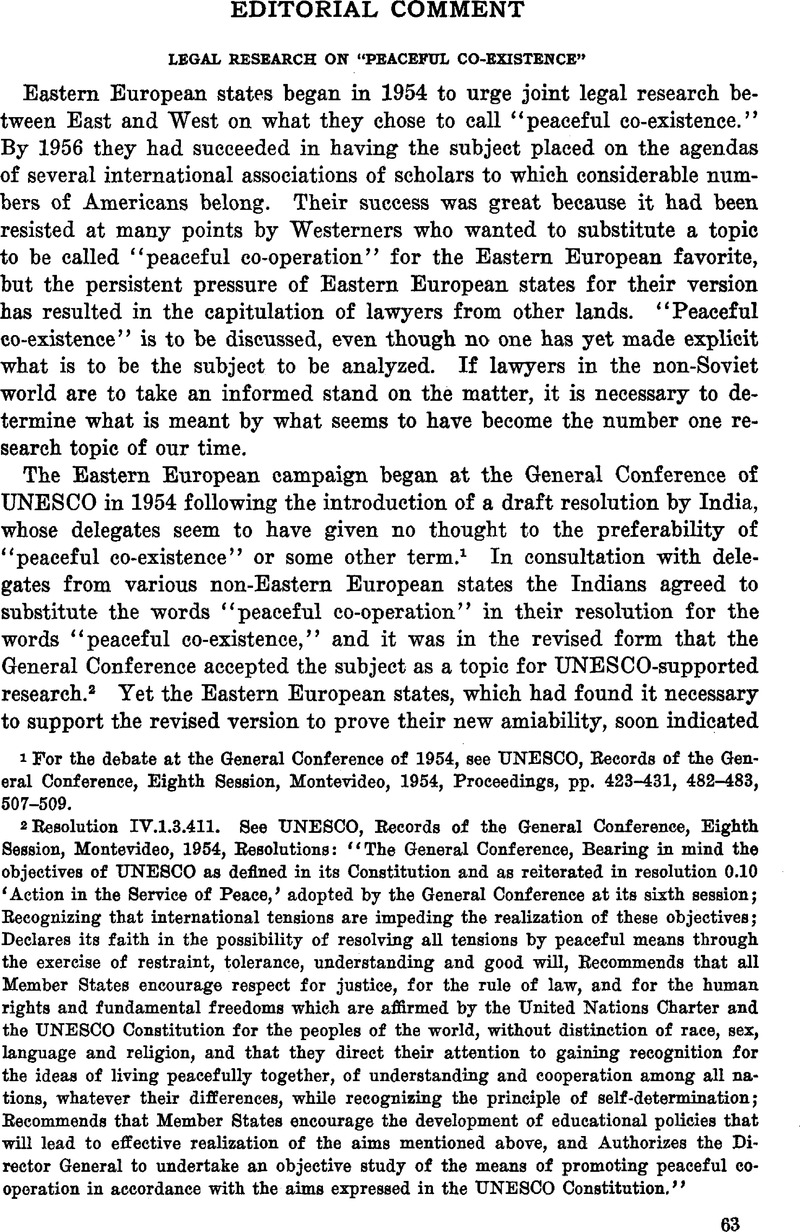Published online by Cambridge University Press: 28 March 2017

1 For the debate at the General Conference of 1954, see UNESCO, Records of the General Conference, Eighth Session, Montevideo, 1954, Proceedings, pp. 423–431, 482–483, 507–509.
2 Resolution IV.1.3.411. See UNESCO, Records of the General Conference, Eighth Session, Montevideo, 1954, Resolutions: “The General Conference, Bearing in mind the objectives of UNESCO as defined in its Constitution and as reiterated in resolution 0.10 ‘Action in the Service of Peace,’ adopted by the General Conference at its sixth session; Recognizing that international tensions are impeding the realization of these objectives; Declares its faith in the possibility of resolving all tensions by peaceful means through the exercise of restraint, tolerance, understanding and good will, Recommends that all Member States encourage respect for justice, for the rule of law, and for the human rights and fundamental freedoms which are affirmed by the United Nations Charter and the UNESCO Constitution for the peoples of the world, without distinction of race, sex, language and religion, and that they direct their attention to gaining recognition for the ideas of living peacefully together, of understanding and cooperation among all nations, whatever their differences, while recognizing the principle of self-determination; Recommends that Member States encourage the development of educational policies that will lead to effective realization of the aims mentioned above, and Authorizes the Director General to undertake an objective study of the means of promoting peaceful cooperation in accordance with the aims expressed in the UNESCO Constitution.”
3 See Doc. UNESCO/SS/Coext./2, Paris, Nov. 24, 1955.
4 See 8 International Social Science Bulletin 196–197 (1956).
5 The themes suggested by the International Economic Association were circulated at the conference of the International Association of Legal Science in a document without reference number.
6 An account of the debate is set forth in Hazard, John N., “International Tensions and Legal Research,” 9 Journal of Legal Education 29–38 (1956)Google Scholar.
7 See Eugene Korovin, A., “The UNESCO Jurists Conference,” New Times, No. 15 (April 5, 1956), pp. 20–23 Google Scholar.
8 For the minutes of the meeting see Doe. UNESCO/SS/Coop/16, Paris, Aug. 8, 1956.
9 See International Association of Democratic Lawyers, Bulletin No. 28, July, 1956.
10 The proceedings of the Dubrovnik conference of the International Law Association will not appear for some time. The influence of the Eastern European delegates upon some members of the conference is indicated by a letter from William Latey to the Editor of The Times (London), who compared the occasion in Dubrovnik with the efforts of the Nazis between the wars to control the activities of the International Law Association by mass votes. See Letters to the Editor, International Law, The Times (London), Sept. 21, 1956.
11 See “An Important Contribution to Peaceful Coexistence,” International Affairs, No. 6 (1956), pp. 12–16 Google Scholar.
12 The study outlines have not been published but are a part of the documentary record of the conference available in the files of the American Foreign Law Association.
13 See Tonkin, Q. I., “Peaceful Coexistence in International Law” (in Russian), Sovetgkoe Gosudarstvo i Provo, No. 7 (1956), pp. 3–13 Google Scholar.